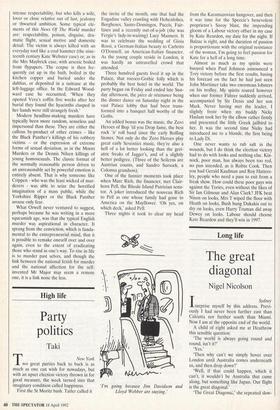Television
Classic ingredients
Martyn Harris
Whenever I consider murdering one of my nearest and dearest it is always the images of the Edwardian murder which occur. The drop of arsenic in the rich aunt's cocoa, or the smear of botulism in the fishpaste sandwich. Then the black plumed horses, the pacing mutes, and the stupendous legacy reverently revealed in the solicitor's office.
In modern-day reality of course they'd get me with a genetic fingerprint or some- thing equally scientific, infallible and tedious. Within three hours of my rich aunt's death I'd be pinned to a garage wall in the searchlight beam of the Hornsey Police helicopter. Murder ain't what it used to be which is why, I suppose, people still find fascination in the creaking con- ventions of Murder, She Wrote, or the cur- rent series of documentary reconstructions, In Suspicious Circumstances, introduced by Edward Woodward (ITV, 9.00 p.m., Mon- day).
In this week's episode a respectable Croydon family sat down to Christmas din- ner in 1923 and within six months three were dead and three more were under sus- picion for murder. Matriarchs tipped arsenic in the arriviste's soup; the arriviste poured it in the matriarch's dessert; the maidservant, maddened by Edwardian con- descension, sprinkled it in everyone's cof- fee. Dull doctors arrived to inspect the massed corpses and to announce their ver- dicts of death by misadventure. Duller policemen turned up to tug their forelocks and to say it was all a mystery to them, guy. The survivors absconded to America.
In a classic essay George Orwell once described the ingredients of the great English murder, and this example was not far off. In the first place the killer must be a minor professional type – dentist, clerk or teacher – living a suburban life of intense respectability, but who kills a wife, lover or close relative out of lust, jealousy or thwarted ambition. Some typical ele- ments of this News Of The World murder are: respectability, poison, disguise, dra- matic flight, sexual motive and domestic detail. The victim is always killed with an everyday tool like a coal hammer (the nine- teenth century Kate Webster case) or, as in the Mrs Maybrick case, with arsenic boiled from flypapers. The corpse is then fre- quently cut up in the bath, boiled in the kitchen copper and buried under the dahlias, or deposited in a suitcase at the left-luggage office. In the Edward Wood- ward case he recounted, 'When they opened Vera's coffin five weeks after her burial they found the hyacinths clasped in her hands were still strangely fresh.'
Modern headline-making murders have typically been more random, senseless and impersonal than these. They are either the callous by-product of other crimes — like the Black Panther's killings of his robbery victims — or the expression of extreme forms of sexual deviation, as in the Moors Murders or the Dennis Nilsen killings of young homosexuals. The classic format of the normally reasonable person driven to an unreasonable act by powerful emotion is entirely absent. That is why someone like Crippen - who was the least wicked of mur- derers - was able to seize the horrified imagination of a mass public, while the Yorkshire Ripper or the Black Panther arouse only fear.
What Orwell never ventured to suggest, perhaps because he was writing in a more squeamish age, was that the typical English murder was aspirational in character. It sprang from the conviction, which is funda- mental to the entrepreneurial mind, that it is possible to remake oneself over and over again, even to the extent of eradicating those who stand in one's way. To rise in life is to murder past selves, and though the link between the national fetish for murder and the national affection for the self- invented Mr Major may seem a remote one, it is a link none the less.



















































 Previous page
Previous page